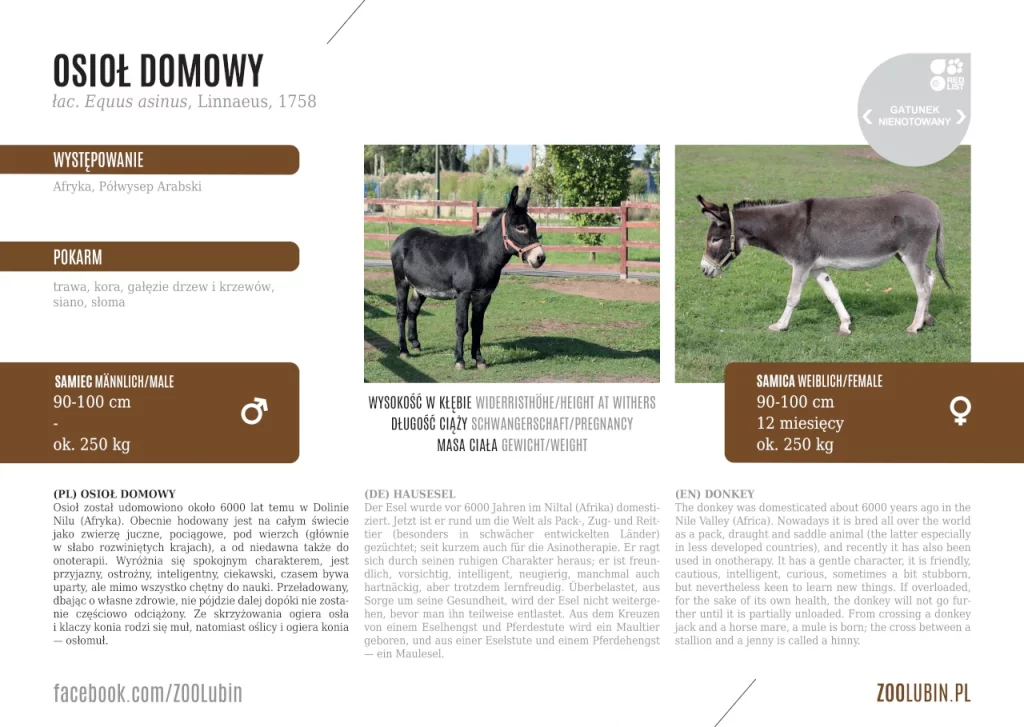
POBIERZ ETYKIETĘ GATUNKOWĄ – PLIK JPG (rozmiar 617 KB)
Osioł domowy (PL)
łac. Equus asinus, Linnaeus, 1758
Osioł został udomowiony ok. 6000 lat temu w Dolinie Nilu (Afryka). Obecnie hodowany jest na całym świecie jako zwierzę juczne, pociągowe, pod wierzch (głównie w słabo rozwiniętych krajach), a od niedawna także do onoterapii. Wyróżnia się spokojnym charakterem; jest przyjazny, ostrożny, inteligentny, ciekawski. Czasem bywa uparty, ale mimo tego pozostaje chętny do nauki. Przeładowany, dbając o własne zdrowie, nie pójdzie dalej dopóki nie zostanie częściowo odciążony. Ze skrzyżowania ogiera osła i klaczy konia rodzi się muł, natomiast z oślicy i ogiera konia – osłomuł.
samiec / samica
Wysokość w kłębie: 90–100 cm
Masa ciała: ok. 250 kg
samica
Długość ciąży: 12 miesięcy
Hausesel (DE)
łac. Equus asinus, Linnaeus, 1758
Der Esel wurde vor 6000 Jahren im Niltal (Afrika) domestiziert. Jetzt ist er rund um die Welt als Pack-, Zug- und Reittier (besonders in weniger entwickelten Ländern) gezüchtet; seit kurzem auch für Eseltherapie. Er ragt durch seinen ruhigen Charakter heraus; er ist freundlich, vorsichtig, intelligent, neugierig, manchmal auch hartnäckig, aber bleibt trotzdem lernfreudig. Wenn überlastet, aus Sorge um die eigene Gesundheit, wird der Esel nicht weitergehen, bis man ihn teilweise entlastet. Wenn Eselhengst und Pferdestute gekreuzt werden, wird ein Maultier geboren, und aus einer Eselstute und einem Pferdehengst − ein Maulesel.
Männchen / Weibchen
Widerristhöhe: 90–100 cm
Körpermasse: ca. 250 kg
Weibchen
Schwangerschaftsdauer: 12 Monate
Donkey (EN)
łac. Equus asinus, Linnaeus, 1758
The donkey was domesticated about 6000 years ago in the Nile Valley (Africa). Nowadays it is bred all over the world as a pack, draught and saddle animal (the latter especially in less developed countries), and recently it has also been used in donkey-assisted therapy. It has a gentle character, being friendly, cautious, intelligent, curious, sometimes a bit stubborn, but nevertheless keen to learn new things. If overloaded, for the sake of its own health, the donkey will not go further until it is partially unloaded. From crossing a donkey jack and a horse mare, a mule is born; the cross between a stallion and a jenny is called a hinny.
male / female
height at withers: 90–100 cm
body mass: ca. 250 kg
female
pregnancy duration: 12 months
